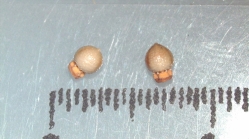Cyperaceae taxon details
Scleria pauciflora Muhl. ex Willd.
1681776 (urn:lsid:marinespecies.org:taxname:1681776)
accepted
Species
- Variety Scleria pauciflora var. caroliniana Alph.Wood
- Variety Scleria pauciflora var. curtissii (Britton) Fairey
- Variety Scleria pauciflora var. pauciflora Muhl. ex Willd.
- Variety Scleria pauciflora var. effusa C.B.Clarke accepted as Scleria pauciflora var. pauciflora Muhl. ex Willd.
- Variety Scleria pauciflora var. elliottii Alph.Wood accepted as Scleria pauciflora var. pauciflora Muhl. ex Willd.
- Variety Scleria pauciflora var. elongata Britton accepted as Scleria pauciflora var. pauciflora Muhl. ex Willd.
- Variety Scleria pauciflora var. glabra Chapm. accepted as Scleria ciliata var. glabra (Chapm.) Fairey
- Variety Scleria pauciflora var. kansana Fernald accepted as Scleria pauciflora var. pauciflora Muhl. ex Willd.
terrestrial
Not documented
Description Plants perennial; rhizomes clustered, elongate, nodulose, to 5 mm thick, hard. Culms usually in tufts, slender,...
Taxonomic remark Source in seed data: wcs Update namepublishedIn from Sp. Pl. 4: 318 1805 to Sp. Pl., ed. 4 , 4: 318 (1805), information...
Description Plants perennial; rhizomes clustered, elongate, nodulose, to 5 mm thick, hard. Culms usually in tufts, slender, (15–)20–50 cm, stiff, glabrous or hairy (villous or ciliate in some forms). Leaves: sheaths sometimes reddish, not or scarcely winged, weakly ribbed, short-pubescent or villous; contra-ligules obtuse to triangular, short; blades linear, channeled, obtuse, shorter than or equaling inflorescence, 1–2.5 mm wide, glabrous or pubescent, sometimes scabrous on margins. Inflorescences terminal cluster, sometimes with 1 or 2 axillary clusters, 0.5–1.5 cm, fasciculate; clusters 2–10 mm wide, each with 1–7 spikelets; lateral clusters remote, on long filiform peduncles; bracts subtending inflorescence leaflike, long awl-shaped, often appearing to be continuation of culm, glabrous or ciliate. Spikelets bisexual or staminate, 3–6 mm; staminate scales lanceolate, membranous, pistillate scales ovate-lanceolate, acuminate. Achenes white or gray and/or with black markings, globose or rarely ovoid, 1–2.5(–3) mm, base narrowly constricted, trigonous, apex umbonate, papillate-verrucose, proximal papillae elongate, retrorse, spiculose; hypogynium brownish, bluntly trigonous border, bearing 6 globose tubercles arranged in distinct pairs, usually finely powdery. [details]
Taxonomic remark Source in seed data: wcs Update namepublishedIn from Sp. Pl. 4: 318 1805 to Sp. Pl., ed. 4 , 4: 318 (1805), information...
Taxonomic remark Source in seed data: wcs Update namepublishedIn from Sp. Pl. 4: 318 1805 to Sp. Pl., ed. 4 , 4: 318 (1805), information provided by Alan E. on email Jun. 07 2021 More details could be found in [details]
Cyperaceae Working Group. (2025). [see How to cite]. Global Cyperaceae Database. Scleria pauciflora Muhl. ex Willd.. Accessed at: https://www.cyperaceae.org/aphia.php?p=taxdetails&id=1681776 on 2025-09-11
![]() The webpage text is licensed under a Creative Commons
Attribution 4.0 License
The webpage text is licensed under a Creative Commons
Attribution 4.0 License
Nomenclature
basis of record
Plants of the World Online (POWO). , available online at https://powo.science.kew.org/ [details]
 Present
Present  Inaccurate
Inaccurate  Introduced: alien
Introduced: alien  Containing type locality
Containing type locality
From editor or global species database
Description Plants perennial; rhizomes clustered, elongate, nodulose, to 5 mm thick, hard. Culms usually in tufts, slender, (15–)20–50 cm, stiff, glabrous or hairy (villous or ciliate in some forms). Leaves: sheaths sometimes reddish, not or scarcely winged, weakly ribbed, short-pubescent or villous; contra-ligules obtuse to triangular, short; blades linear, channeled, obtuse, shorter than or equaling inflorescence, 1–2.5 mm wide, glabrous or pubescent, sometimes scabrous on margins. Inflorescences terminal cluster, sometimes with 1 or 2 axillary clusters, 0.5–1.5 cm, fasciculate; clusters 2–10 mm wide, each with 1–7 spikelets; lateral clusters remote, on long filiform peduncles; bracts subtending inflorescence leaflike, long awl-shaped, often appearing to be continuation of culm, glabrous or ciliate. Spikelets bisexual or staminate, 3–6 mm; staminate scales lanceolate, membranous, pistillate scales ovate-lanceolate, acuminate. Achenes white or gray and/or with black markings, globose or rarely ovoid, 1–2.5(–3) mm, base narrowly constricted, trigonous, apex umbonate, papillate-verrucose, proximal papillae elongate, retrorse, spiculose; hypogynium brownish, bluntly trigonous border, bearing 6 globose tubercles arranged in distinct pairs, usually finely powdery. [details]Taxonomic remark Source in seed data: wcs Update namepublishedIn from Sp. Pl. 4: 318 1805 to Sp. Pl., ed. 4 , 4: 318 (1805), information provided by Alan E. on email Jun. 07 2021 More details could be found in [details]





